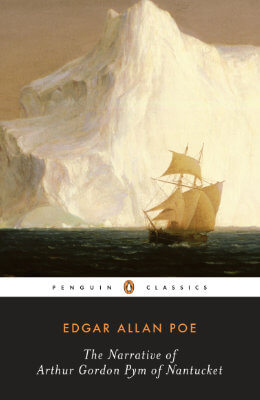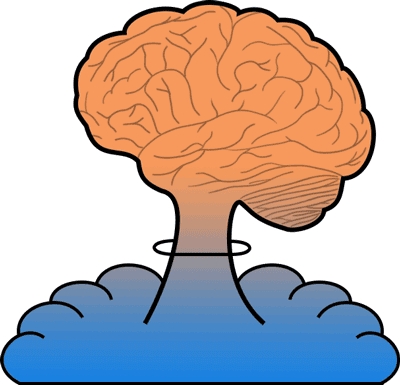Introduction
Very rarely do I read novels that are older than myself these days.
Not because they are poorer in quality – after all, most great classics of literature were produced in the past centuries – but because they usually do not integrate the group of narratives that could be potentially analysed in this website.
I chanced upon Edgar Allan Poe’s 19th century novel, The Narrative of Arthur Gordon Pym of Nantucket, after inspecting René Magritte’s painting “Not to Be Reproduced” (I’ll soon write an article about this painting).
Curious about Magritte’s intention to depict this particular book in his work, I decided to have a go and read it before analysing Magritte’s painting.
Well, if you are reading this, you won’t be surprised of it’s inclusion here. For a novel written in mid 19th century, it is unexpectedly weird! Edgar Allan Poe was known for his eccentricity and this novel (his only one, to be said) epitomises Poe’s style.
In fact, I don’t think I had ever read a novel that ended in such anticlimactic manner. If this was Poe’s intention, it was a decidedly canny and bold decision, as the ending has been the source of numerous analyses, even nowadays.
So let’s get straight down to it!
Review
The Narrative of Gordon Pym of Nantucket is a novel written by American writer Edgar Allan Poe in 1838. It is Poe’s only novel and it narrates the adventures of Arthur Gordon Pym, a young man with a passion for sailing.
The novel begins with a preface supposedly written by Pym after the events of the novel have taken place.
The first few chapters tell the story of Pym on board of first the boat Ariel and then the whaling vessel Grampus, and involves pretty much everything you would expect from a sea voyage drama: violent storms, shipwreck, mutiny, delirium and sharks. Pym also narrates some of the most macabre events in his narrative, such as the crew’s resort to cannibalism to survive and ghastly descriptions of putrid bodies.
The last few chapters are by far the most interesting, but also the source of much analysis. Pym and the Jane Guy’s crew encounter a tribe of natives living in a hitherto unexplored island near Antarctica.
There are several tribulations that put Pym in a precarious position, and just as you feel the novel reaching a climax, the narrative abruptly ends in an utterly confusing way.
The novel is short, and it moves at a quick pace. For this reason, characters are not terribly fleshed out and Poe did not spare the clichés.
Even though I was concerned about the most gruesome events in the book, for which it was heavily criticised, I felt critics were blown out of proportion. To be sure, there ARE gruesome events, such as decaying corpses and cannibalism, but it’s not as if Poe delves into the gritty details; in fact, these scenes barely make one paragraph. I have read popular crime novels that are way more ghastly and repugnant than Poe’s novel. So, even if you’re squeamish, don’t be put off by all the negative reviews you read describing how gruesome the novel is, because it really isn’t that bad.
Generally, I found the book an interesting read. The writing is not always accessible, but I had little trouble following it through to completion. Despite not being a huge fan of maritime disaster stories, I felt the story line was quite engaging.
I do, however, have a few critique points.
There were some clear plot inaccuracies. For example, Tiger, Pym’s dog, mysteriously vanishes from the book after Pym and allies successfully quell the mutiny. There is no mentioning of whether he is alive, or got killed during the altercation by one of the mutineers, or drowned after the strong gale that assaulted the Grampus.
Given that Tiger had a fundamental role in saving both Pym’s and Augustus’ life during the riot, simply casting aside the dog as if he never existed seems very odd at best.
Second, I also couldn’t help but notice that for someone who was supposed to be a newbie in the art of sailing, Pym knew a great deal of the technicalities of navigation. I believe that Poe wanted to take the opportunity to share his knowledge with the readers, and since the book is being told from a first person narration, there was really no way around it.
Third, when Pym discovers a letter attached to Tiger, he finds, to his chagrin, that the letter is completely blank. He then (correctly) realises that there could be text written on the other side of the letter. However, when Augusts re-tells the story as it happened to him, he mentions that he wrote the text to Pym on the back of a written letter: “Paper enough was obtained from the back of a letter – a duplicate of the forged letter from Mr. Ross”. Thus, Pym should have seen something written on both pages of the letter.
Fourth, Pym mentions that the reason Augustus heard him was because Pym dropped a bottle and the crash alerted Augustus. He also mentioned that he only learns about it years later when Augustus plucked the courage to tell Pym. However, this cannot be right, since Augustus dies a few weeks later after the mutiny, while still aboard the Grampus.
Fifth, the Tsalalians apparently have convulsions when seeing the colour white. Fair enough. However, what about clouds? What about the white of the eye? Shouldn’t they be convulsing preety much all the time?
Another point of criticism is the awfully tedious explanations that Poe incorporates whenever he assumes the reader should be familiar with certain facts (e.g., about seals, birds, previous explorers). You see, I admire authors who attempt to explain concepts that may be helpful in understanding parts of the story (after all, this is an important aspect of this website). Unfortunately, I found that Poe is terrible at it. His descriptions are appallingly boring.
Perhaps it is just me, but not only did I lose interest in most of these sections but also they reminded me entries of an encyclopedia.
Not only that but I felt that most of these interludes were put there either as padding, or simply to make Poe look like an expert in the field. I honestly felt these sections intrusive, as they broke the narrative with tangential information that added nothing to the story line.
More positively, I found the subplot of Tsalal really imaginative and exciting though. The multi-coloured water, the vapour curtain, the ruins, the mysterious fauna and natives all contributed to create a world that couldn’t be further from the repetitive and often monotonous events at sea.
Nevertheless, ending Pym’s narrative in such an anticlimactic way naturally leaves readers frustrated. Sure, the lack of a definite conclusion to the story attracts numerous attempts to explain the ending, but I feel that the cut was simply too premature.
Star rating
When deciding which rating I should give to this novel, I was torn between 2 and 3 stars. The reason for the lower score being that I think the narrative could have been better arranged. There are many inconsistencies, outright boring sections and the lack of resolution upon reading the final chapter made me lean towards a score of 2.
However, I have to admit the book was pretty engaging. Poe really knew how to write explosive thriller/action stories. Furthermore, stories like nautical disasters tend to get monotonous easily. Yet, I did not feel any repetition, so I’m sure you won’t get bored (apart from, perhaps, the tangential explanations).
Because I would recommend the book despite the issues outlined above, I decided to go middle ground and give it 2.5 stars.
Bizarrometer
The book is at times difficult to read due to Poe’s distinctive writing style. The story is not hard to follow though, and you won’t have any issues following it through – that is, except the last chapter, which ends in an extremely ambiguous manner.
Nevertheless, the weirdness in the last chapter is still manageable. I suppose most of the readers will be more frustrated with the deliberate omission of a concluding chapter that could shine some clarity into the story.
Here, The Narrative of Arthur Gordon Plym of Nantucket gets a Bizarrometer score of 3.
The Narrative of Arthur Gordon Pym of Nantucket: What is it all about?
The reason you are probably reading this article is because you would like to understand Pym’s fate at the end of the novel. Unfortunately, Poe gives us very little cues for a globally acceptable interpretation.
However, given that Poe was acquainted with the notion of a hollow Earth (i.e., that the Earth is hollow on the inside and houses other worlds inhabited by advanced civilisations), one interpretation for the ending of the novel is that Pym, Peters and deceased Nu-Nu have reached one of the entrances to the hollow Earth. One of these entrances is situated, so goes the notion, in the south pole, exactly where the events after Pym’s escape from Tsalal take place.
This interpretation is supported by some bizarre events in the novel which resemble suggestions and alleged sightings by hollow Earth proponents (e.g., temperate climate, warm water, strange fauna and flora).
On the other hand, Poe loved the idea of the unreliable narrator, and used the technique in countless of his other works. The Narrative of Arthur Gordon Pym of Nantucket might be one of them.
Pym, as a narrator, is incredibly unreliable. In the preface, he admits that he didn’t keep a diary for most of the journey, had to recall most things from memory and might even have exaggerated some of the descriptions. There are also many errors in his narrative that hint at a possible fabrication of the events.
Finally, the preface also notes that Poe ghost-wrote the first chapter, whereas Pym is supposed to have written the remaining chapters. This divide could also be interpreted as the divide between reality and fiction. Perhaps Pym did exist and experienced the misadventures on board of his boat Ariel. However, after passing out, the events that follow (i.e., on Grampus and Jane Guy) could be the result of visions or even dreams.
I’ll detail these interpretations later on in this article. However, given that Poe was most likely influenced by the notion of a hollow Earth, I should explain what that is before a deeper analysis of the novel.
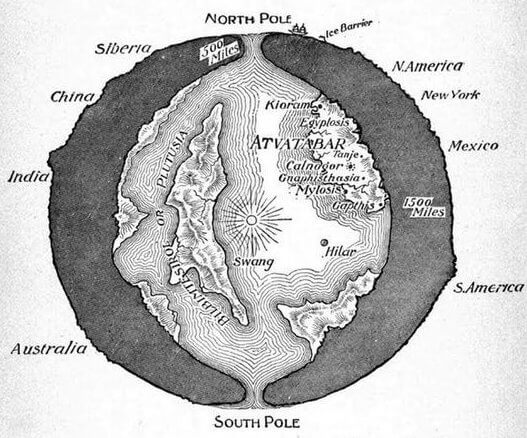
The Hollow Earth
In the late 17h century there appeared a theory that suggested that the planet Earth is hollow inside. Its proponent was famous astronomer Edmond Halley. Halley was very interested in the structure of the planet Earth but disturbed by the observation that Earth’s magnetic field looked so unpredictable. So, to explain his unusual observations, Halley concluded that something must be moving in the inside of Earth which was affecting Earth’s magnetism.
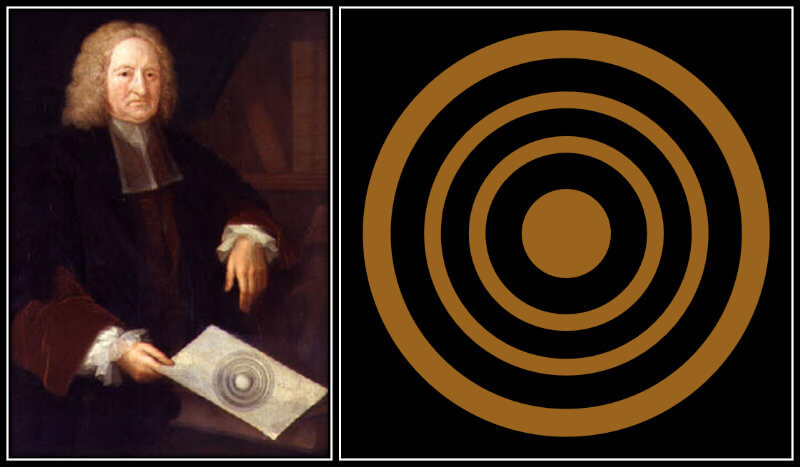
Haley proposed that Earth consisted of three concentric shells surrounding a central hollow core. The three shells would have their magnetic poles slightly misaligned. As the shells rotated, this misalignment would disrupt the Earth’s magnetic field up on the surface of the Earth.
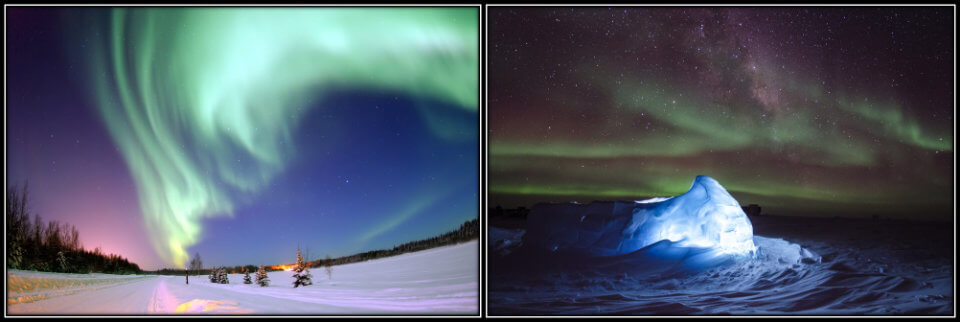
The space between the shells, he went on, likely contained luminous and, possibly, life-supporting atmospheres. He also famously speculated that the Aurora Borealis resulted from gases escaping the inner of the Planet.
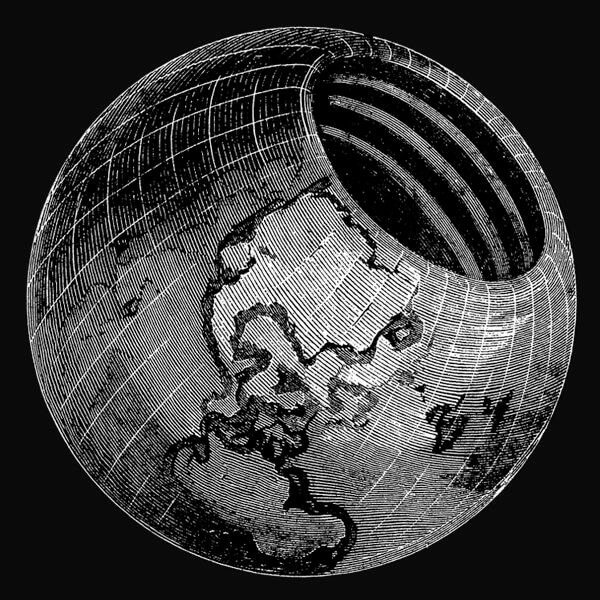
Later, in 1818, American Army officer John Cleeves Symmes Jr. published his Circular no. 1, where he announced that there existed large holes at both North and South poles which served as entrances to the inside of the Earth (which came to be known as Symmes holes).
One convert of Symmes’s theory was Jerimiah N. Reynolds, a newspaper editor and author, who most likely influenced Poe’s novel.
When his mentor died, Reynolds took up the task to promote Symmes Hollow Earth theory to the US public. He even embarked on an expedition to the South Pole. After weathering a severe storm and other maritime obstacles, he and his crew managed to reach the Antarctic shore, and survived on sea-lion meat.
Due to a couple of further misadventures, Reynolds and his crew became convinced that they could not enter the South Pole, so they decided to set sail and head back home. However, his crew mutinied in Chile and he was forced to leave the ship.
Reynolds joined the United State frigate “Potomac”, under the command of Commodere John Dowes on his way to India. It was at about this time Reynolds wrote the book “Address on the Subject of a Surveying and Exploring Expedition to the Pacific Ocean and the South Seas” which was allegedly the most important source for Poe’s novel.
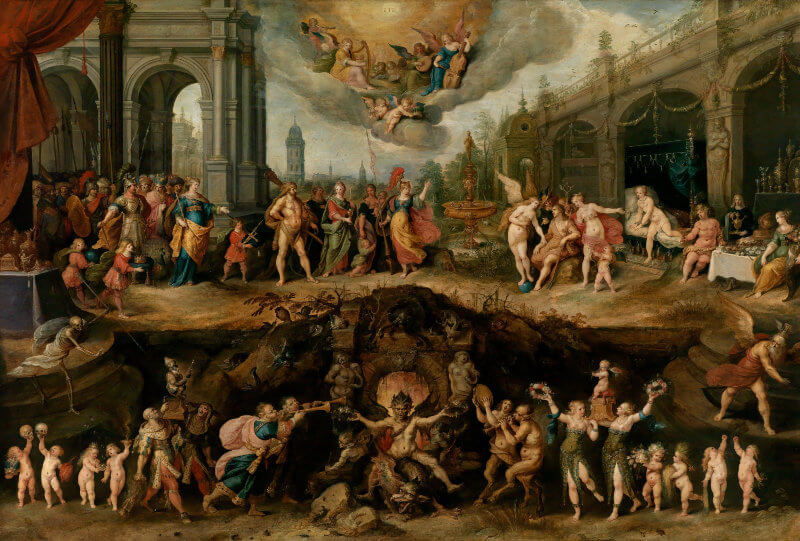
The innards of inner Earth
Many ancient cultures believed that there existed another world inside of planet Earth. This is interesting in a way because these ancient cultures (e.g., ancient Greeks, Buddhists, Christians) believe there is a hell that is located somewhere below the surface of the planet.
Mexican folklore mention the existence of a mountain cave near Ojinaga, where fiendish creatures from the interior of the Earth find abode. In Buddhism, they speak of a place called Agartha, located right at the center of the planet, and supposedly inhabited by a very advanced civilisation.
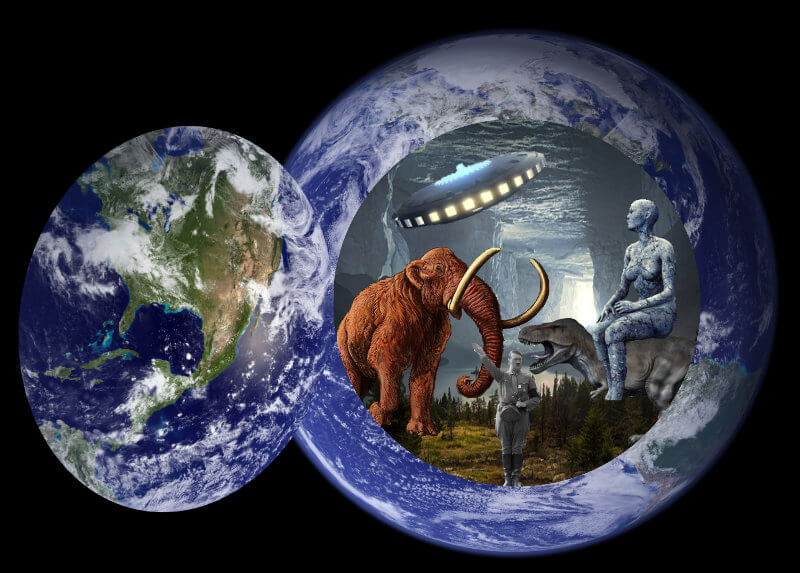
In the last couple of decades a great many sailors and explorers have claimed to have sighted the interior of the planet, but there is little consensus as to what exactly resides inside the hollow Earth.
For example, some advocate that there are advanced civilisations living there; some are more parsimonious, suggesting the presence of labyrinthine cavern systems running through the whole of inner Earth; some believe the inner worlds are not entirely different from our own, and that we could be living on one of these inner worlds; some suggest the presence of giant super-humans and even woolly mammoths and dinosaurs; some even believe that Hitler did not die in the second world war, but found refuge in the inner Earth with some fellow Nazis.
But despite fantasies of what and who might find abode inside a hollow Earth, no one as of today found any entrance at the poles to this inner realms, as some hollow Earth proponents predict that exists.
Of course, we can simply load up Google Earth and verify that there are no chasms on either pole. But even that doesn’t deter hollow Earth believers, as some claim that Google Earth and similar satellite imagery programmes have hidden the entrance holes to the inner realm as part of a larger conspiracy.

The problem is that we cannot drill too deep into the Earth’s crust because it gets really, really hot the farther down you go.
The deepest hole humans managed to bore was the Kola Superdeep Borehole in Russia, a measly 12 km (for reference, the distance to the center of the Earth is about 6371 km). They couldn’t drill any further down because it got so hot (180° Celsius/356° Fahrenheit), that the equipment simply couldn’t cope with the heat.
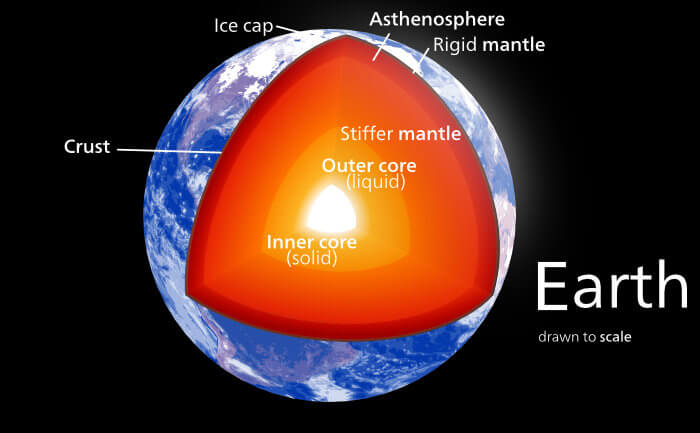
Is there any evidence of a Hollow Earth?
No, there isn’t! Planet Earth is not hollow, quite the opposite in fact. Let’s consider a few scientific observations.
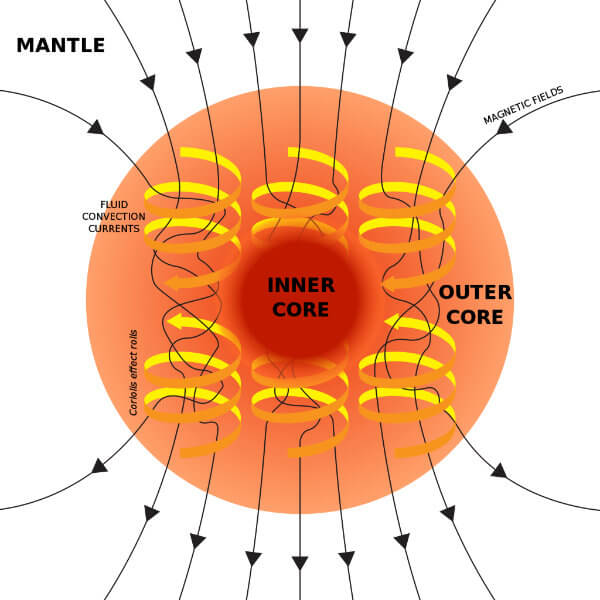
1. The only reason Earth has a magnetic field (and there is no dispute here) is because there is a molten iron core at the center of the planet. Remove the iron core and Earth would not have a magnetic field to shield us from very harmful radiation from the solar wind and other astronomical events. Life as we know it, would simply not be possible.

2. Another consequence of a hollow Earth would be that we would see the aurora basically everywhere on Earth. The only reason we see the auroras only at the poles (the aurora borealis and aurora australis) is because Earth’s magnetic field drives ions (charged particles) from the Sun towards the poles. There, they collide with atmospheric gases, which reaction produces those jaw-dropping lights.
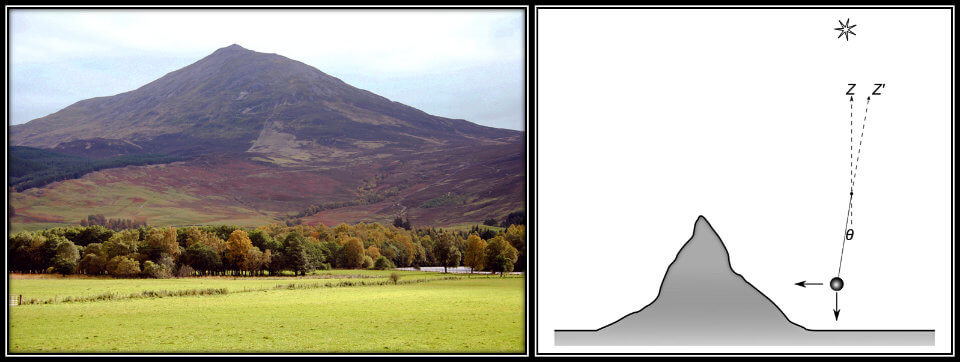
3. Careful and repeated measurements have indicated that the density at the Earth’s surface is way lower than the average density of the entire Earth. By simple logic, that clearly suggests that there must be something much denser below the surface, so the idea of absurdly gigantic cave systems or Earth-like worlds in the interior is implausible.
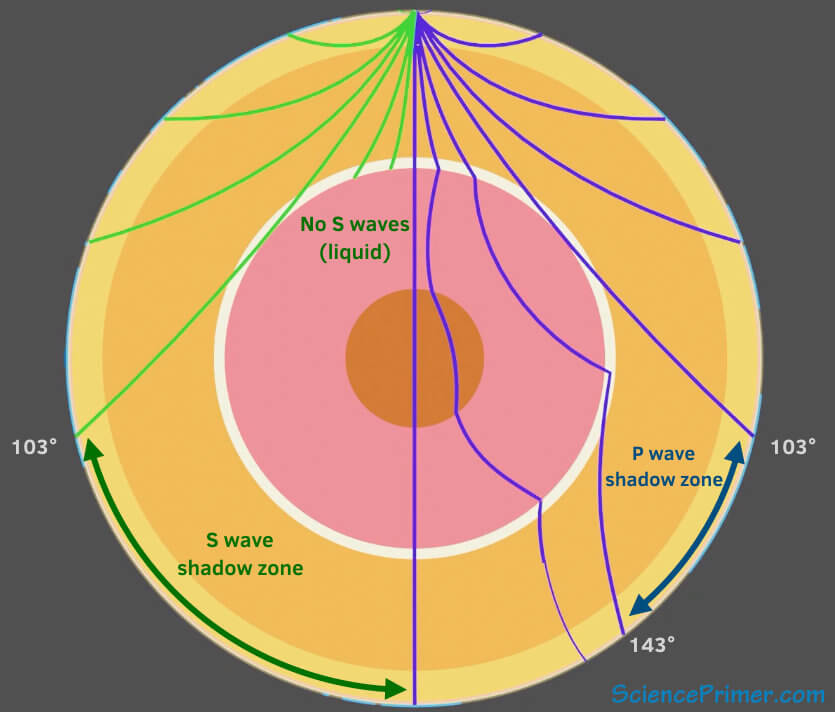
4. The analysis of seismic waves generated by earthquakes in inner Earth directly contradicts a hollow Earth hypothesis.
When an earthquake occurs somewhere inside Earth, two types of waves are created: Primary (or P) waves and Secondary (or S) waves. These waves propagate in all directions from the epicenter (i.e., the center) of the earthquake, so scientists place detectors (seismometers) at several locations across the planet to detect these waves.
P waves travel faster than S waves so, all things being equal, P waves are the first to arrive from the epicenter of the earthquake (by the way, scientists are able to determine where the epicenter of the earthquake is, by timing how long it took for the S and P waves to arrive at different locations around the world).
Another difference between P and S waves relate to their movement. P waves move longitudinally, and longitudinal waves have the ability to pass through solids, liquids and gases. S waves, on the other hand, move transversely, and transverse waves can only pass through solids (if S waves hit liquids or gases, these will prevent their propagation).
Temperature also matters. Whenever waves pass through hot regions they slow down. For instance, S waves are weakened when passing through the asthenosphere, and completely come to a halt when they reach molten regions.
Both P and S waves propagate faster the denser the material is. That means they speed up as they get closer to the center of the Earth (because density increases with depth).
Finally, whenever the waves reach a boundary between layers the waves can be reflected, absorbed or transmitted. When transmission occurs, they are often refracted (i.e., change direction) because waves change speed when density also changes (changes in density occur between layers).
Remember that scientists have placed seismometers around the globe, so they are able to detect seismic waves in many, many locations.
So, when scientists combine the data from multiple seismometers, given the known behaviour of waves when crossing different mediums, they are able to infer the composition of Earth’s interior.
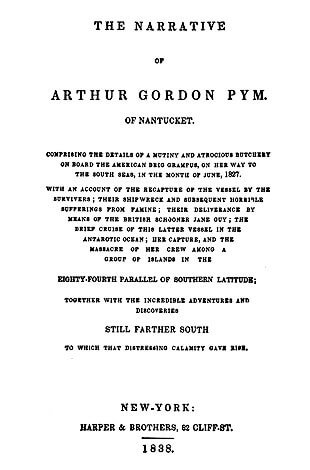
The Narrative of Arthur Gordon Pym of Nantucket: the analysis
The Narrative of Arthur Gordon Pym of Nantucket is really made up of three parts:
Chapter I describes Pym’s misadventure at sea with his friend Augustus. They leave a party and Augustus suggest sailing into the sea with Pym’s boat Ariel, to which Pym agrees. After realising Augustus is terribly inebriated, Pym sees himself having to fend himself off with little sailing experience. As Pym comes to terms with his own imminent demise, he passes out just as he hears “a loud and long scream or yell, as if from the throats of a thousand demons”. He and his friend Augustus wake up in the whaling ship Penguin, having been rescued by the frigate that had just returned from its voyage.
Chapters II till XIII describe Pym’s adventure on board of Grampus, commanded by Augustus’ father Captain Bernard. Because Pym isn’t allowed into the ship, he and his friend concoct a plan in which Pym hides in a hold until they are sufficiently far off the coast as to make a return to Nantucket impossible. Pym becomes delirious in his confinement after Augustus fails to bring him food and water. We later learned the reason for Augustus absent, which was that a mutinity arose. Pym, Augustus and another member of the crew, Peters, successfully come out victorious. After a dreadful time wandering at sea, they come across a lonely ship carrying decaying corpses. Not they sacrifice one of the crew members and resort to cannibalism to survive. Augustus eventually dies of his wounds a few days later, but Pym and Peters are saved by Jane Guy.
Chapters XIV till XXV describe the events on board Jane Guy and the encounter with the Tsalalians. By far, the most intriguing events, as far as the analysis of this work is concerned, take place in the last 5 chapters, when the Jane Guy’s crew meet the natives of the island Tsalal.
The relationship between the natives and the crew is initially cordial and pacific, despite some apprehension noted by Pym. They begin a mutual arrangement, but Pym notices some peculiar behaviour, like avoiding anything white and an increase in number of Tsalalians.
The situation changes when the islanders trick the some of the crew, and trap them in a gorge. T who luckily were further away.
His fear of betrayal becomes a reality when the villagers set the Jane Guy’s crew up and try to bury them all alive. The entire crew perishes entombed in the gorge, except Pym and Peters, who survive. They find peculiar chasms and markings on the rocks, and survive by catching a few animals that cross their way.
They witness the ambush to the ship, which explodes violently.
Due to a shortage of food and drink, they venture downhill, where they meet an aggressive group of natives. They successful subdue them and bring a captive along on their escape off the island on canoes.
Now, the weirdest part of the novel takes place. Pym notices many bizarre events, such as milky water, huge cataract, giant birds. The captive dies of fear, and Peters becomes catatonic as they approach the curtain of vapour.
The novel abruptly ends with the appearance of a strange white shrouded figure.
In the next sections, I’d like to discuss three versions as to the fate of Pym.
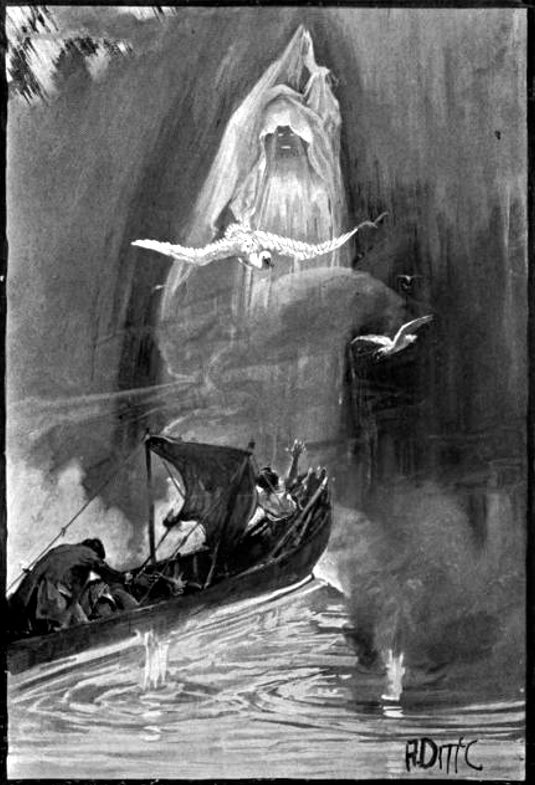
Pym enters a hollow Earth but returns safely to the US
As Poe writes in the final note, Pym returned to the US where he later died of a sudden but unspecified accident, which was covered by the media.
Pym states in the preface that he didn’t keep a journal during a large portion of the trip, so he had to write the events from memory. According to the editor, all the events reported in the book have actually happened to Pym.
The question is whether we should take Pym’s narration literally (and there are reasons to doubt that; see below). If we are to believe his story, then it is very likely that the openings Pym mentions near the cataract are the entrances to the interior of Earth, considering how acquainted Poe was with the concept of hollow Earth.
There are, indeed, a few descriptions in the novel that support this interpretation.
While navigating towards the south pole Pym notices very strange phenomena.
The temperature of the sea and air increasing further south they sail
OK, it is very obvious that the further south you sail, the colder the water should become right? The crew passes the Cape of Good Hope in South Africa and proceed southwards to explore unexplored Antartic regions. Pym relates that the water gets increasingly warmer the southern they sail, which is weird, since they are getting closer to the South Pole, so the water should be cooler.
At some point during their escape “the heat of the water still increased, and the hand could no longer be endured within it”. So the temperature of the water reached such a level that even putting the hand was out of question.
Also, note that Pym mentions that the temperature of the air became surprisingly milder and the weather even pleasant, which defies logic.
Why would water get warmer and the temperature of the air milder the closer they were to the chasm? Well, according to hollow Earth believers, if Earth is really hollow then the interior should be warmer.
One of the fiercest hollow Earth proponent, John Symmes, actually proposed that the region closest to the poles is actually warm. Perhaps, heat from the hollow Earth permeated the seas on the surface near the division between inner and outer Earth shells. Of course, for dramatic effect, Poe greatly exaggerates Pym’s description on how hot the water was.
Multi-coloured and milky white water
Near the Bennet’s Isle, Pym notes that the sea is “of an extraordinarily dark color”.
Continuing the journey, the water transformed into distinct veins of multiple colours. This is how Pym describes it: The water “was not colourless, nor was it of any one uniform colour […] the whole mass of liquid was made up of a number of distinct veins, each of a distinct hue; that these veins did not commingle; and that their cohesion was perfect in regard to their own particles among themselves, and imperfect in regard to neighboring veins”.
Pym attempts to blend the veins by cutting them across, but is utterly unsuccessful. Then he tries to cut along their edges, which segregates them even more. So no matter what he tried, he simply couldn’t mix the original state of the veins.
In the final chapter Pym again notes that there is another perceptible change in the colour of the sea. The colour changed yet once again and was “no longer transparent, but of a milky consistency and hue”.
So, the characteristics of the water changed the further south the Pym travelled:
1) the typical transparent colour (as we know it)
2) dark colour (around Bennet’s isle)
3) thick multi-coloured “veins” (in Tsalal)
4) milky consistency and hue (near the cataract)
This transformation from transparent to thickly white is interesting, although nothing I have read about hollow Earth theories suggest anything of the kind.
The Tsalalians seem to drink the multi-coloured water and, as Pym writes, it is “as perfectly limpid as any limestone water in existence”. Perhaps, the coloured water is a mere consequence of the interaction between the supernatural coming from the hollow Earth and the island. The water becomes purer the closer they get to the chasm: the perfect water being milky white.
In fact, there is another putative benefit of the natural resources found in Tsalal. Apparently, the scurvy grass cured disease among the crewmen: “[…] the scurvy grass proved of incalculable benefit in restoring those of our men who had shown symptoms of disease. In a very short time we had not a single person on the sick-list”.
Tsalal, being the island most connected to the hollow Earth, may be benefiting from the curative and medicinal properties of the advance civilisation purportedly dwelling inner Earth.
Vapour curtain
“A high range of light gray vapour appeared constantly in the southern horizon, flaring up occasionally in lofty streaks, now darting from east to west, now from west to east, and again presenting a level and uniform summit – in short, having all the wild variations of the Aurora Borealis. The average height of this vapour, as apparent from our station, was about twenty-five degrees”.
The mentioning of the Aurora Borealis is very interesting because when the original hollow Earth theory was proposed by Edmond Halley he explained the phenomenon as gases from the interior of the Earth finding their way up through holes on the surface of the Earth.
The vapour eventually rose so much that it created a kind of silent cataract covering the whole southern horizon and seemed to rise limitless in the sky.
There is no explanation why the vapour curtain formed, but it probably served as a barricade against unwelcome visitors.
Unusual fauna and flora
As soon as Jane Guy arrives in Antarctic waters the crew is welcomed by a series of strange animal sightings.
The description of the white mammal spotted just off the coast of Tsalal is very telling: “it was three feet in length and six inches in height, with four very short legs, the feet armed with long claws of a brilliant scarlet, and resembling coral in substance. The body was covered with a straight silky hair, perfectly white, The tail was peaked like that of a rat, and about a foot and half long. The head resembled a cat’s, with the exception of the ears – these were flapped like the ears of a dog. The teeth were of the same brilliant scarlet as the claws”.
Furthermore, Pym notes that “holes” in the curtain of vapour momentarily form, within which he is able to make out wide indistinct figures.
In addition, when they get closer to the cataract, Pym spots gigantic white birds flying just beyond the cataract emitting the “tekeli-li” sounds that are also voiced by the Tsalanians.
As Jane Guy was approaching Tsalal, the crew caught a carcass of a white land-animal “three feet in length and six inches in height, with four very short legs, the feet armed with long claws of a brilliant scarlet, and resembling coral in substance. The body was covered with a straight silky hair, perfectly white, The tail was peaked like that of a rat, and about a foot and half long. The head resembled a cat’s, with the exception of the ears – these were flapped like the ears of a dog. The teeth were of the same brilliant scarlet as the claws“.
The word tekeli-li is first mentioned in chapter XXII, after Captain Guy’s ship explodes. The white carcass that had been kept on the ship catapulted to the shore, at which point the natives panicked and began yelling “tekeli-li”.
The second mentioning of the word tekeli-li happened when Pym and Peters decide to attach a sail made of their white shirts to the mast: “We attached a sail made of our shirts […]. The sight of the linen seemed to affect him in a very singular manner. He could not be prevailed upon to touch it or go near it, shuddering when we attempted to force him, and shrieking out Tekelili!“.
The third muttering of tekeli-li happened when Pym and Peters escape the natives with their captive Nu-Nu. Pym takes out a white handkerchief, which triggers violent convulsions in Nu-Nu, followed by drowsiness and stupor. He kept muttering tekeli-li.
The fourth and last mentioning of the word was the shriek of the gigantic white birds flying close to the curtain of vapour forming in the southern horizon.
So, what do all these events have in common?
The colour white!
The natives seem to fear the colour white because it is associated with the frightening beings that live over the cataract, which apparently are all of a perfect white colour.
There is another scene when the crew meet the natives for the first time and Captain Guy waves a white handkerchief up in the air (presumably to indicate they come in peace).
The villagers come to a halt and hesitate, shouting all at once including words like Anamoo-moo and Lama-Lama. It is not mentioned the word Tekeli-li, but “commenced a loud jabbering all at once, intermingled with occasional shouts, in which we could distinguish the words Anamoo-moo and Lama-Lama“.
So, it’s likely the word tekeli-li was said, but that Pym simply did not catch it.
As mentioned above, the natives do not know the colour white and seem to fear the white animals that sporadically come close to the island.
In that case, tekeli-li might simply signify a sort of alarm call that is used to alert fellow villagers whenever something white emerges.
All these descriptions tantalisingly resemble some of the accounts of unknown fauna like super huge animals.
Pym also reports on the strange flora present in Tsalal that did not resemble that of anywhere else on Earth and notices unusual rocks with novel mass, colours and stratification.
Giant human figure beyond the chasm
In the final event of the novel, the cataract splits open as if to let the boat pass through, at which time a giant human figure appears before them: “a shrouded human figure, very far larger in its proportions than any dweller among men. And the hue of the skin of the figure was of the perfect whiteness of the snow“. Well, some hollow Earth explorers tell stories of giants and/super-humans living in the inside of the planet.
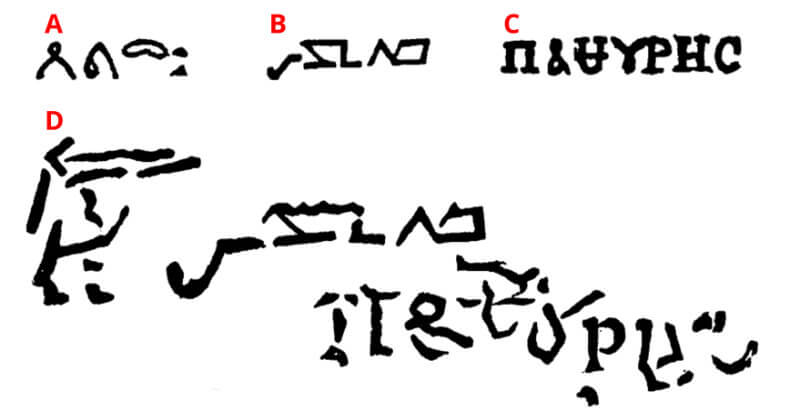
The mysterious markings on the rocks
One of the great unexplained events of this novel are the peculiar chasm formations and the mysterious engravings that Pym and Peters discovered on the Tsalalian rocks.
The shape of the chasms (in the order Pym found them) make up the characters in A in the figure above, and signify “To be shady” in Ethiopian. The editor of the final note further adds “whence all the inflections of shadow or darkness”.
Considering that it is a part of Tsalal that is shaped in this way, it is tempting to conclude that Tsalal is representing darkness.
The indentures (D in the figure above) are potentially easier to interpret. According to Peters, the most leftward drawing is an artwork, and depicts a human with an outstretched arm. This figure is pointing towards the other characters, which are in Arabic and Egyptian and mean “To be white” and “The region of the south”, respectively. Again, the editor of the final note further adds “whence all the inflections of brilliancy and whiteness“.
Clearly “the region of the south” is the region beyond the cataract, since the further Pym travels south the more the water becomes milky white. Furthermore, the skin of the huge figure is purportedly of a perfect whiteness.
So whereas Tsalal is a representation of darkness and all that is impure in the world, “the region of the south” (i.e., the world beyond the cataract) represents perfection.
Even though Tsalal appears to contain magical properties (such as curative grass), the Tsalal natives may nevertheless be entrapped to a life of servitude. This is consistent with the enigmatic last sentence of the novel:
“I have graven it within the hills, and my vengeance upon the dust within the rock“.
“graven” is the past participle of “to grave”, which is an archaic form of engraving something on a surface. So I interpret this quote as the vengeance being engraved within the rock of the chasms.
In other words, those indentures linking “white” to perfection could be from someone (or something) that cast terror on the island, which is why Tsalalians are always so terrified of the white creatures.
By the way, one of the most cryptic events of the entire novel is when Pym asked Nu-Nu why his fellow islanders were so determined to assassinate the entire crew. Nu-Nu simply raised his upper lip with the index finger in order to show his black teeth.
Why would he do such a thing? What do the natives’ black teeth have anything to do with the deaths of the white men?
Tsalalians seem to abhor the colour white, so one explanation could be that Tsalalians believed the Jane Guy’s crew (with their white teeth) are a threat to their existence, just as they felt threatened by the white animals roaming nearby.
So, perhaps Nu-Nu was pointing out the fact that the white men have white teeth, which by association must be conniving with the other terrifying white creatures, and this is the reason the natives wanted to get rid of them.
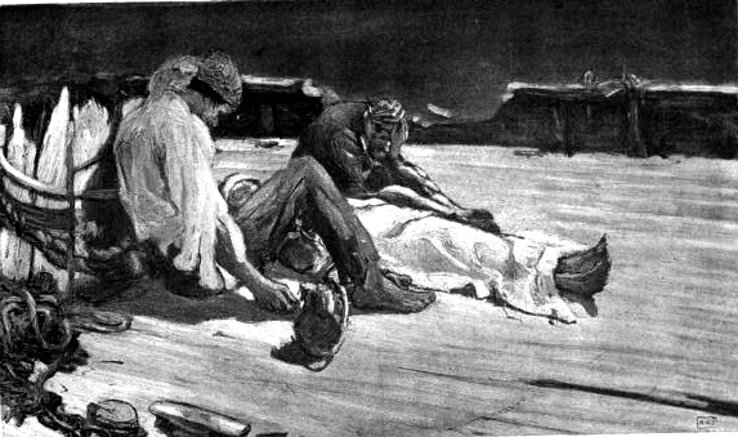
Pym dies as soon as he enters the chasm
Once I finished reading the novel, my conclusion was that Pym and Peters died upon seeing the huge figure. The reason is because it would fit the abrupt ending of the book; since it is a first-person narrative, the narration would end once the narrator perished.
However, this interpretation is problematic for many reasons.
If Pym really dies after entering the chasm, then there can be neither a diary nor a mouth to tell the story from memory. You see, everyone that set sail on the Grampus and Jane Guy died, so no-one could have told the story on Pym’s behalf.
The idea of doubting the events Pym describes highlights the concept of unreliable narrator. This is a technique most commonly used in first-person narratives, in which the narrator tells the story in a way to mislead readers and, therefore, is not trustworthy. Indeed, Poe made use of unreliable narrators in several of his short stories (e.g., “The Tell-Tale Heart”, “Ligeia”, “Murders in the Rue Morgue”, “The Pit and the Pendulum” just to name a few), so this technique ranks among one of his favourites.
Take this excerpt from the preliminary note as an example: “A narrative, let me say, which, in its latter portions, will be found to include incidents of a nature so entirely out of the range of human experience, and for this reason so far beyond the limits of human credulity, that I proceed in utter hopelessness of obtaining credence for all that I shall tell, yet confidently trusting in time and progressing science to verify some of the most important and most improbable of my statements.“
To my hears that sounds like: “I’m telling these events which are beyond the range of human experience, because I never really witnessed them so they never really happened and you shouldn’t trust me“.
He also writes: “[…] having kept no journal during a greater portion of the time in which I was absent, I feared I should not be able to write, from mere memory, a statement so minute and connected as to have the appearance of that truth it would really possess, barring only the natural and unavoidable exaggeration to which all of us are prone when detailing events which have had powerful influence in exciting the imaginative faculties“.
Essentially, Pym is excusing himself that one of the reasons he was reluctant to share his narrative, was because he had to re-tell everything from memory. Because of this, there is very possibility that some events in the narrative are greatly exaggerated and are, therefore, not entirely truthful.
Lastly, Pym writes the following:
“[…] the incidents to be narrated were of a nature so positively marvellous, that, unsupported as my assertions must necessarily be (except by the evidence of a single individual, and he a half-breed Indian), I could only hope for belief among my family, and those of my friends who have had reason, through life, to put faith in my veracity – the probability being that the public at large would regard what I should put forth as merely an impudent and ingenious fiction”.
OK, this is really suspicious. First off, Pym blatantly tells us that his narrative is unsupported and will remain so. The only person that could corroborate his story is Peters.
Well, in the final note Poe mentions that Peters is alive and living in Illinois but, wait for this … is unavailable! That’s not much more convincing than when I say “yes, I really saw a unicorn in Scotland, but unfortunately he is hiding in a cave under a Loch, so no point in looking for it”.
Unless I got this completely wrong, I think this is a rather cheeky way to make readers cast even more doubt on Pym’s writings. Poe could have written that Peters died, found a wife and has three kids or something else entirely. But no, he explicitly tells us that Peters “cannot be met with at present”, when he is the only individual with the power to bring this whole story to conclusion.
How strange it is that Pym writes the preface saying that he consented to the publishing of the novel and warned readers “where his portion ends and my own commences“. Did Pym already know the contents of the book before it went to press? So how come there isn’t a final chapter?
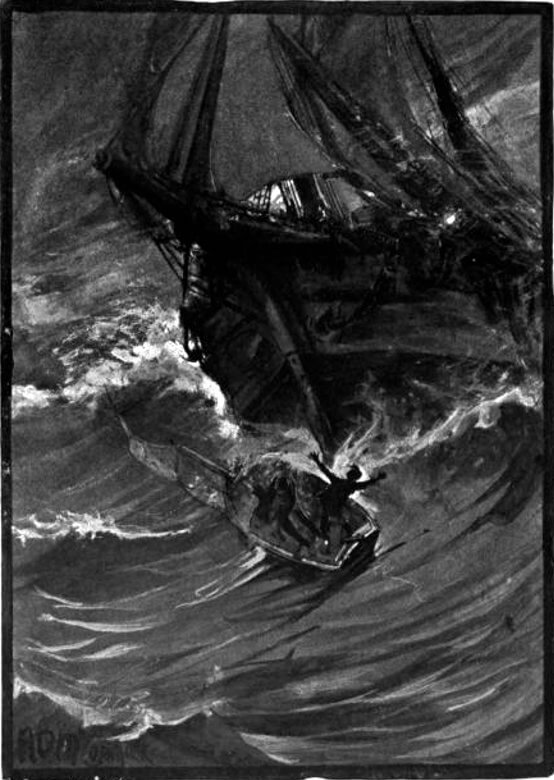
Pym is delirious or dreaming after fainting on Ariel
This is probably the weakest of the three interpretations, as far as evidence is concerned, but it’s definitely my favourite. It could actually be construed as a potential explanation for the unreliable narrator.
What if the events after the rescue of Pym and Augustus on the Ariel by the whaling-ship Penguin until the end of the book are nothing more than Pym’s visions or dreams? There has been suggestions that the shrouded human figure at the end of Pym’s narrative could actually be the distorted figure of a ship – that of Penguin!
In chapter I, as Pym and Augustus face death on board Ariel, Pym suddenly hears “a loud and long scream or yell, as if from the throats of a thousand demons, seemed to pervade the whole atmosphere around and above the board. Never while I live shall I forget the intense agony of terror I experienced at that moment […] I tumbled headlong and insensible upon the body of my fallen companion”.
Three notable points here.
First, “a loud and long scream or yell, as if from the throats of a thousand demons” could be the screams (“tekeli-li“) of the white giant birds that flew over Pym as they approached the entrance of the chasm.
Second, this is exactly the point when Pym collapses, but still barely sees the ship approaching. Third, penguins (the name of the vessel that rescued Pym was called Penguin) are the source of much interest in the final chapters of the book and are found in Antarctica.
Taking a more psychological route, perhaps the vapour curtain represents the conscious divide – when Pym crosses the consciousness barrier he snaps out of his stupor and becomes conscious. This would certainly explain some of the bizarreness of the narrative (the dog Tiger mysteriously disappearing, strange fauna and flora, weird and thick multi-coloured water, cataract extending into the sky, etc.).
Curiously, Alyssa M. Amaral in her article Racial and Cultural Anxieties in Poe’s The Narrative of Arthur Gordon Pym (see section “A Haunting Figure” on page 23), writes that there may be reasons to believe that as Pym and Peters approach the chasm, “the men see, either figuratively or literally, the outline and figure of a penguin”.
Furthermore, Pym mentions that as they kept traveling south, inching towards the cataract, he felt “a numbness of body and mind – a dreaminess of sensation”.
Shortly after he sees a white animal floating in the water, but he is overwhelmed with a sense of lethargy. At this time, Peters becomes apathetic and Nu-Nu enters a state of stupor. This all seems to indicate that coming nearer the curtain of vapour affects their conscious senses.
It would also explain why the first series of events (the one with Pym and Augustus venturing to sea with Ariel) is somewhat disjointed from the rest of the novel; it adds virtually nothing to the principal story line. So, it begs the question, why didn’t Poe simply start with the Grampus story line?
One explanation is actually given by the preface. As it is reported, the first few pages were actually ghost-written by Poe himself “[…] and it will be understood that the no fact is misrepresented in the first few pages which were written by Mr. Poe”, whereas the later chapters were written by Pym’s first-hand account.
This division between what Poe wrote and what Pym wrote is what makes me wonder the authenticity of the events narrated by Pym.
Of course, this is all speculative, because there isn’t a single direct indication from Poe that any of the events Pym narrates did not actually happen to Pym.
However, in the initial note, Pym shows reluctance in publishing his adventures as true, so Poe suggests to have it published under the guise of fiction, to which Pym agrees.
It should be noted that “The Narrative of Arthur Gordon Pym of Nantucket” has also been analysed with respect to the historical context within which the novel had been written: the turbulent years leading to the American Civil War.
The black villagers of the south island of Tsalal are terrified of anything white, which has been interpreted as the racial polarity that had established between the North and South of the United States.
Some critics have labeled Poe as a racist, pointing out his upbringing in southern United States in the early 19th century.
Poe makes constant associations of black with savagery and evil whereas white is linked with purity and perfection.
His exaggeration of how the natives look like have also raised concerns: the natives are completely black, even their teeth, they don black clothes, they speak an incomprehensible language, and are portrayed as unintelligent, ignorant and evil.
This is what Pym wrote about the natives: “the most wicked, hypocritical, vindictive, bloodthirsty, and altogether fiendish race of men upon the face of the globe“. It has been suggested that this was the opinion that many southern white Americans at the time had of southern slaves.
On the other hand, some critics have also suggested that the interaction between the northern white men and the southern black natives is Poe’s critique to colonialism, imperialism and slavery that was prevalent during his lifetime. The white men seem to consider the island natives inferior, and cunningly exchange subpar items (e.g., beads) for valuable raw materials readily available in the island.
Furthermore, Pym mentions that their interactions are cordial and friendly, but the white crew refers to the natives as “savages”, simply because the natives’ culture is strange to the white men. In addition, all trade is done under the vigilance of armed white men and always carried out with a sense of distrust for the islanders, evincing a certain hipocrisy.
The blatant colonialism is apparent when Jane Guy captain’s suggests erecting suitable houses as a means to explore the island’s natural resources, and stationing some of his crew there to oversee that the work is done properly.
Relatedly, some authors believe that the natives’ attack on the white men could be Poe’s omen of what could happen if tensions between North and South intensify. As the natives almost entirely eliminate Jane Guy’s crew, Poe might be making a point that colonialism and expansionist actions are most likely to backfire.
Conclusion
I’d read that Poe’s unique and only novel has been a much-debated work of literature. And now I can see why. I cannot recall ever reading a book that ended so prematurely and right at the very climax of the story.
Having expected a much tedious work with endless descriptions of nautical concepts and repetitive episodes, I was positively surprised that Poe decided to emphasise Pym’s thrilling adventures. The novel is short, quick-paced. Even though there are outright boring sections of needless descriptions which are mostly irrelevant to the story line, it is a nice read overall.
The novel starts off as a typical adventure book at sea, with everything that could happen, happening: violent storms, shipwreck, delirium due to shortage of food and drink, mutiny, cannibalism. However, it is in the last few chapters that Poe’s imagination really comes to fruition. After Pym’s adventures and misadventures at sea on board of Ariel and Grampus, the emergence of Tsalal with its unique landscape, fauna, flora and inhabitants make a nice and rousing change.
The novel ends abruptly with Pym, Peters and deceased Nu-Nu floating towards a chasm with a huge human white figure blocking the passage.
In this article, I presented three interpretations:
1) Pym enters a hollow Earth. This interpretation is supported by certain descriptions in the text that resemble what some hollow Earth proponents believe (e.g., water and temperature becoming increasingly hot; unique and giant animals and the huge human-like figure).
2) Pym dies when entering the chasm. This account emphasises the unreliable narrator aspect of the novel, since, in this case, it’s impossible for the editor to know what had happened to Pym. Then, the entire novel is an attempt to confuse the reader.
3) Pym is delirious and/or dreaming. Pym’s narration of the events follow his rescue by the whaling-ship Penguin to the encounter with the giant human-like white figure, is nothing more than Pym’s vision or dream. There are a few indirect clues to make a case, such as Tiger’s sudden disappearance, the bizarreness of the entire Tsalal episode, Pym’s allusions to dreaming and alterations of consciousness when coming close to the chasm, or the more tentative relationship between the shrouded human-like figure with the whaling-ship Penguin.
The reader will for sure expect more of, and be even slightly frustrated with the ending. However, we cannot argue with the fact that this is very much the appeal of Poe’s novel. It certainly makes for a good discussion!
Final note
Poe is, unquestionably, an incredibly creative writer. “The Narrative of Arthur Gordon Pym of Nantucket” found echo among several famous authors, among who, Jules Verne (the “Journey to the Center of the Earth” strikes me as a perfect example of that influence).
For this reason alone, I devoted much more wording to the interpretation in which Pym reaches the hollow Earth, as it tends to be the topic that most readers find appealing.
However, I fully acknowledge that an analysis of this novel isn’t at all complete without carefully examining the contentious racial symbolism that is ubiquitous in the novel. I made a brief mention in the section Racial symbolism in the Narrative of Arthur Gordon Pym of Nantucket, but I’m aware it only scratched the surface of a undoubtedly much more complex topic.
See you in the next article!

